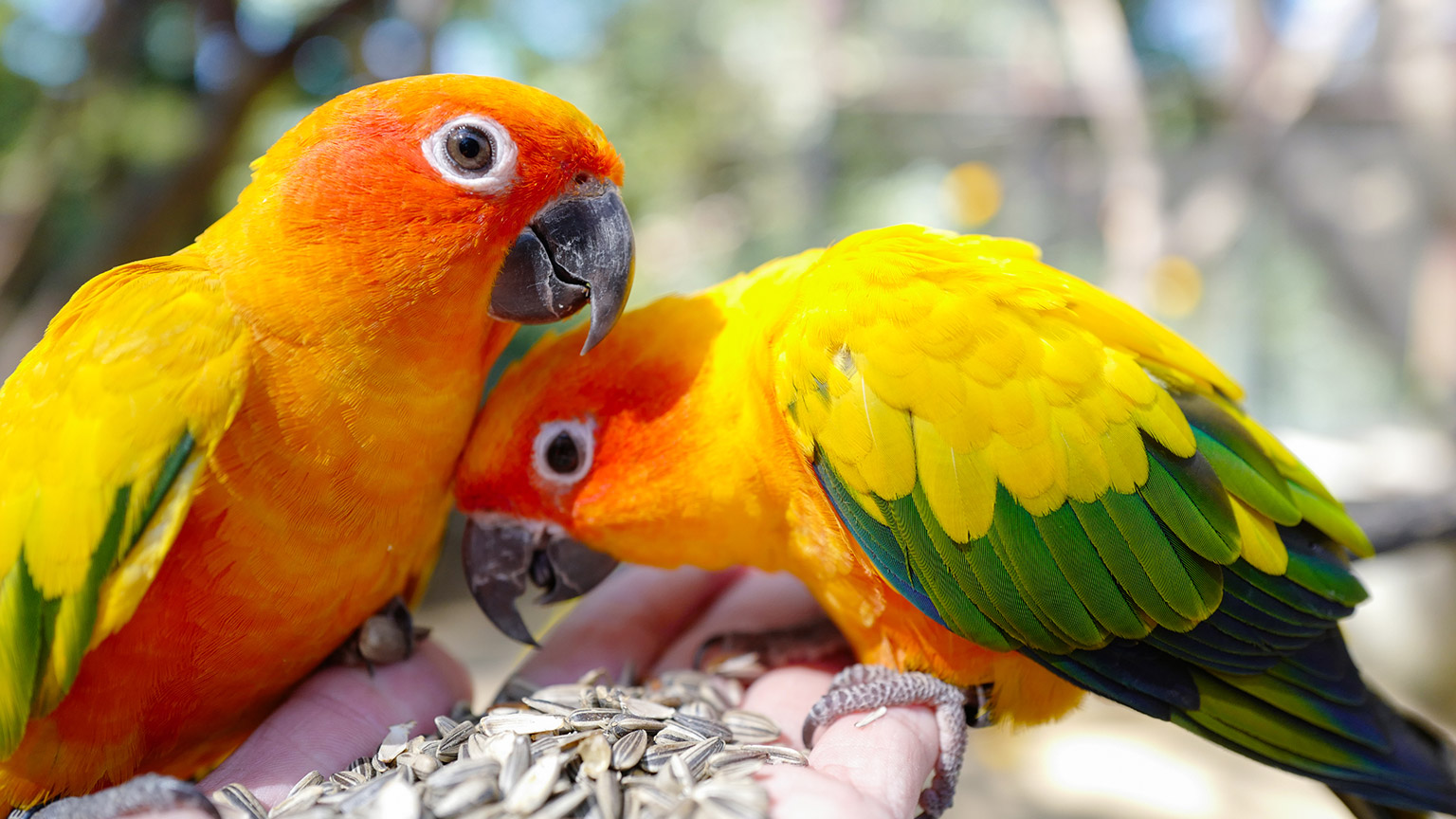Before you learn how to feed and water animals, it is important to understand the basic principles of animal welfare and ethics.
Ethical management and handling of animals are critical to the animal care industry. As an animal carer, it is your responsibility to behave ethically when working with animals. You can think about ethical behaviours as ‘doing the right thing’ or ‘doing what is best’ for the animal.
You can be confident that you are upholding animal ethics if you follow the principles of animal welfare.
Principles of Animal Welfare
We referred to this in Module One, but let’s take a moment to review what the Principles of Animal Welfare are.
There are eight key principles of animal welfare.
- Animals should not suffer from prolonged hunger
- Animals should not suffer from prolonged thirst
- Animals should have a comfortable environment
- Animals should have enough space to be able to move around freely
- Animals should be free of physical injuries
- Animals should be free of disease
- Animals should not suffer pain, fear or stress
- Animals should be able to express normal, non-harmful, social behaviours.
The following table summarises the principles and how you can uphold them as an animal carer in the workplace.
| PRINCIPLE | THE ANIMAL SHOULD HAVE ACCESS TO: | AS AN ANIMAL CARER, YOU SHOULD: |
|---|---|---|
| Animals should not suffer from prolonged hunger |
|
|
| Animals should not suffer from prolonged thirst |
|
|
| Animals should have a comfortable environment |
|
|
| Animals should have enough space to be able to move around freely |
|
|
| Animals should be free of physical injuries |
|
|
| Animals should be free of disease |
|
|
| Animals should not suffer pain, fear or stress |
|
|
| Animals should be able to express normal, non-harmful, social behaviours |
|
|
In this course, your focus is on providing the animal with appropriate food and water; and conducting safe and humane handling.
In this course, your focus is on providing the animal with appropriate food and water; and conducting safe and humane handling.
Upholding animal welfare and ethics often requires some compromise. For example, cats eat mice and rats. If you follow the principle that animals should be able to express normal behaviours, you might consider feeding a cat a live mouse. However, you must also consider the welfare of the mouse! In an enclosure, the mouse has no means of escape from its predator, which is highly stressful for the mouse. The cat may not make a clean kill, meaning the mouse may suffer unnecessary pain and distress. In its attempt to escape, the mouse will likely bite the cat in defence. Depending on the severity of the bites, the cat could be injured or become ill if the bites become infected. In short, feeding live mice to cats fails to meet more welfare principles than it meets and so is considered unethical.
Safe and humane animal handling techniques and procedures
You must have a good understanding of your facility's safe and humane animal handling techniques and procedures. Follow the specific techniques and procedures relevant to the species you are handling and all times. When handling an animal, you must always do so in a manner that is safe for you and the animal. It is also important to remember that:
- owners of the animals will watch you to learn how to handle their animal properly;
- handling animals correctly will prevent other staff from being injured; and
- handling animals appropriately will help reduce stress for the animal.
Preparing to handle an animal
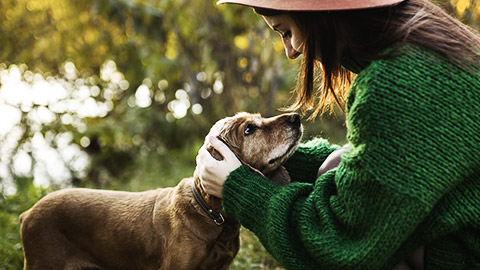
Give the animal you will handle your total concentration before and during handling. Safe handling requires you to have a good knowledge and the ability to read the body language of the animal that you are handling. Don’t rush straight in and put your hands on the animal. Instead, take a few moments to visually assess the animal that you are about to handle. Ask yourself some questions to evaluate the animal and the situation. Of course, you may ask hundreds of other questions, depending on how the animal arrived and with whom. However, the following are just a few questions you might use to assess the situation and identify the safe handling techniques that may be appropriate.
- Is the animal wild or someone’s pet? Wild animals are unlikely to have had much contact with people and may be very difficult to handle.
- Do you have a history for this animal? Can you ask the owner about the animal’s behaviour?
- Is the animal well socialised?
- Is the animal injured or unwell?
- Is the animal stressed? Many animals will be stressed simply being in the unfamiliar environment of an animal care facility.
Taking a few moments to assess and interpret the animal’s behaviour will make it easier for you to handle it and safer for both of you. The techniques you choose to handle the animal will vary depending on the situation.
Handling sick or injured animals
Animals tend to be less accepting of handling when sick or injured. So, it is vital to be able to recognise when an animal is sick or injured. Some common signs of illness and injury in animals may include:
- laboured breathing
- the presence of blood
- the presence of mucous
- open wounds
- limbs at odd angles
- limping
- whimpering
- lethargy
- not eating.
It is important to remember that even the calmest animal in the world can bite in response to pain. Your handling technique may vary on the type of illness or injury. No matter what, following the health and safety guidelines and your facility’s policies on handling animals is essential. If you have any doubts about the temperament or health of an animal, ask another staff member for assistance. There is no reason to take shortcuts. The safety of all concerned is paramount.
Safe animal handling techniques
The following are a few examples of safe and humane animal handling techniques.
- Concentrate on the animal you are handling without being distracted by other activities.
- Do not put your face directly into the face of an animal. The animal may find it threatening and you might get scratched or bitten.
- Do not move in behind or crowd around an animal.
- Avoid direct eye contact but maintain safe visual contact with the animal.
- Talk in soothing tones. Avoid high-pitched, excited talking.
- Never sit on the floor while handling an animal. There may be a chance that the animal might become aggressive or aroused, making it hard for you to get up or move out of the way or protect yourself from kicks, scratches or bites (Rural Area Vet, n.d.).
Safe and humane animal handling requires a thorough understanding of each species' typical behaviour and responses, as well as using the correct techniques. There is no substitute, however, for careful observation and experience.
Watch: How to pick up a cat like a pro - Vet advice on cat handling (6:53 minutes)
The following video demonstrates how to approach and pick up a cat safely. Different animals require different techniques.
Activity
How much have you remembered? Take a moment to complete the following activity.
All animals need to eat food to survive. The type of food they require depends on the species of animal as well as its life stage and other individual requirements. Depending on their specific nutritional requirements, different animals will also need to be fed at different frequencies. For example, a 3-week-old kitten may need to be fed every 4 to 6 hours, while an elderly adult cat may only need to eat once a day. So, before you feed an animal in an animal care facility, you must first confirm whether it is feeding-time for them. This information is part of the animal’s feeding plan. You can also locate this information by:
- checking with your supervisor
- reading the:
- cage card
- hospital charts
- treatment board.
- completing the rounds of the cages
- getting a verbal handover from the previous shift.
- Feeding plans
A feeding plan provides instructions about what the animal should be fed and how often. The cage card attached to the animal’s cage or enclosure typically outlines the critical aspects of the feeding plan. A more detailed feeding plan will be kept in the animal’s file. You will need to familiarise yourself with the location of feeding plans in your organisation. Feeding plans may include instructions about:
- Feeding plans
- types of food to feed the animal
- any required medications or supplements
- feeding frequency, rates and times
- feeding methods and procedures such as:
- hand feeding
- bottle feeding
- free feeding
- controlled feeding.
- how to introduce dietary changes to the animal
- nutrient requirements for the animal according to its life stage and condition
- how to present food to stimulate activity and allow the animal to mimic normal wild behaviour
- supervisor instructions, such as:
- liquid diets
- restricted diets.
- target weights
- reporting and recording requirements
- weed and pest control strategies (when feeding animals food containing seeds).
A targeted feeding plan will support the treatment of many medical conditions, such as diabetes, obesity and pregnancy.
Take a look at the following case study about Watermelon the Guinea Pig. Guinea Pigs are not specifically listed as companion animals under this programme, but they are a member of the rodent family like mice and rats are, and they are also very popular small pets in New Zealand. The information provided for Watermelon will be similar to the needs of rats, mice and sometimes rabbits.
Case Study
Watermelon
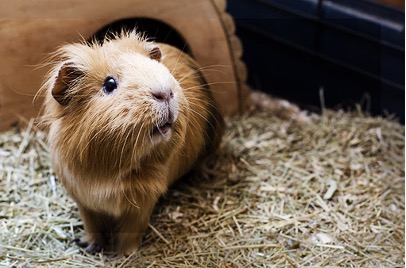
Watermelon is a guinea pig being cared for in the boarding section at Emily’s SPCA. The following table is the information included on a cage card located on her cage in the boarding facility.
| WELLINGTON SPCA BOARDING | ||||||
|---|---|---|---|---|---|---|
| Animal name: Watermelon |
Owner name: Truss Owner number: 0400 800 800 |
Species: Cavy (guinea pig) Breed: Satin Age: 1 year Colour: Golden |
Sex: Female Desexed: No Weight: 470 g |
|||
| STAY | FEEDING | SERVICES | ||||
|
Date in: 18/07/2022 Date out: 01/08/2022 |
Product: Fresh vegetables (named container in the fridge) Amount: 1/2 cup per meal Frequency/timing: Morning and evening |
Hydrobath - flea/tick: No Hydrobath - medicated: No Hand bath: No Clip (details): No |
Clip (details): No Nail clip: Yes |
|||
| VACCINATIONS | PREVENTATIVE HEALTH | MEDICATION / SUPPLEMENTS | ||||
|
Due date: n/a Type: |
Product: Due date: |
Product: Vitamin C powder Dose: 1/2 scoop daily Timing: Evening, on food |
||||
| Notes: | ||||||
| DATE | EAT | DRINK | URINE | FAECES | MEDICATION | NOTES: |
Identify food and food supplements and prepare in line with feeding plans
While the feeding plan provides feeding instructions, it is helpful to understand the nutritional needs of animals and how they can change during their life as they age or become ill.
Basic nutritional requirements
Different species of animals have different basic nutritional needs. Even within a species, such as cats and dogs, different breeds have different dietary requirements. Nutritional needs will also vary depending on the individual’s age, weight, gender, lifestyle, genetic makeup and general health.
SEVEN TYPES OF NUTRIENTS
While specific nutritional requirements vary, seven types of nutrients are essential for all animal health, growth and development. Select each of the following nutrient types to learn more.
Carbohydrates are the primary source of energy for movement and growth for most animals. Animals typically get their carbohydrate needs from grains (Ron Fields Nutrition n.d.).
Proteins are vital for the growth and development of the animal. Proteins are present in all animal tissue types, such as skin, muscle and organs. Proteins also form enzymes and some hormones, which keep bodily functions happening (Ron Fields Nutrition n.d.).
While meats are very high in protein, many animals get their protein needs from plant-based foods such as nuts, seeds and grains.
Fats are used to produce cell membranes and some types of hormones. Fats are also used to store energy and help the body absorb other nutrients, such as fat-soluble vitamins. Fats can also help give an animal a glossy coat, especially in horses, and improve milk production, such as in dairy cows (Ron Fields Nutrition n.d.). Foods such as fish oils and vegetable oils are common sources of fats in animal diets.
Fibre is critical for healthy digestion. It can help the animal absorb water and other nutrients, as well as promote the growth of good gut bacteria. The structural components of most plants, such as grasses, stems and leaves, are made of fibre. So, most herbivores get plenty of fibre in their diets. However, it has been shown that even carnivores, such as cats and dogs, benefit from fibre in their diet (Williams 2011).
Vitamins are organic compounds that are vital for a range of different bodily functions. For example, vitamin A is essential for good vision, general growth, foetal development and immune function, while vitamin K is critical for blood clotting in dogs (Burke 2020). Different vitamins are present in various foods, which is why a varied diet can be important for many animals. Vitamins can also be given to animals in the form of supplements.
Minerals are inorganic substances that are critical for normal bodily functions in animals. Seven of the most common minerals required in animal diets are:
- phosphorus
- calcium
- chloride
- magnesium
- potassium
- sulphur
- sodium (Hill's Pet Nutrition 2018).
Water is essential for the health of all animals. Water is vital to keep the animal hydrated, allowing it to regulate its temperature and prevent overheating. Water is needed for “regulating pH, assisting with digestion, joint lubrication and energy production” (Ron Fields Nutrition n.d.). All animals need a constant supply of clean drinking water.
A balanced diet will consist of all seven nutrient types in varying amounts, depending on the general diet type and species.
GENERAL DIET TYPES
All animals can be broadly classified into three groups based on the type of food they eat.
- Carnivores – animals that eat meat and other animal products
- Herbivores – animals that eat plant products
- Omnivores – animals that eat a combination of animal and plant products.
Watch: Heterotroph Examples (3:18 minutes)
The following video gives a brief overview of the differences between carnivores, herbivores and omnivores.
Post Watch Task: Check your understanding of the terms in the video by completing the following activity. Read the question, decide on your answer then click the + on the right-hand side to find out how well you did
Yes
No, some bacteria and fungi decompose other living organisms for energy so are also heterotrophs
Yes, some plants such as the Venus Fly Trap are heterotrophs.
Within these three groups, there are more specialised diet types. Polyphagy is the ability of an animal to eat a variety of food. This may mean the ability to eat both plant and animal products, such as in humans or dogs, or it may mean the animal can eat a wide range of the same general food type, such as cats being able to eat birds, mammals and reptiles.
In rare cases, some diets are so specialised, the animal can only eat one type of food and other foods will make them ill. This type of diet is called monophagy. For example, Koalas can only eat eucalyptus leaves. Other types of plant materials disrupt their digestive system and make them sick.
The following table provides just a few examples of the more specific diet types within each of the three main categories.
| CARNIVORE SUBCATEGORIES | HERBIVORE SUBCATEGORIES | OMNIVORE SUBCATEGORIES |
|---|---|---|
|
|
|
GENERAL NUTRITIONAL REQUIREMENTS
Good quality and balanced dry food that lists protein as its first ingredient is important for cat and dog nutrition. This is especially true for cats because they are obligate carnivores – animals whose diets are at least 70% meat and can’t digest plant materials properly (Australian Museum 2018). Dry food has the added benefit of helping prevent dental disease as the animal chews.
Many high-quality commercial wet foods also provide a balanced diet. Animals can also be fed semi-moist or raw food diets. For example, herbivores, such as rabbits and guinea pigs, need a balance of good quality pellets, hay, fresh fruit, and vegetables.
There are benefits to all types of diets. The critical thing to remember is that whatever the kind of diet, it must meet the animal's nutritional needs.
Fresh, clean, cold water must be available at all times for all species of animals unless there is a specific reason, such as a surgical procedure scheduled in the next 6-12 hours.
Exceptions to a typical diet, such as restricted water, will be noted on the feeding plan and should be followed at all times.
Specific animal nutritional needs
As mentioned previously, different animal species have different nutritional requirements. In this course, we will focus on the specific needs of the following:
- Cats
- Dogs
Cats are carnivores, which means they get all their nutrition from eating other animals. Dogs are omnivorous and so get their nutrients from a range of both plant and animal products.
The following table summarises the key nutritional requirements of a balanced diet for cats and dogs.
| NUTRIENTS | CATS | DOGS |
|---|---|---|
| CARBOHYDRATES | There is no minimum dietary requirement for carbohydrates in cats. Domestica cats are true carnivores and do not need dietary carbohydrates because they use glucogenic amino acids and glycerol to synthesise glucose. Cats tolerate well-cooked, nonfibrous carbohydrates. However, uncooked carbohydrates are poorly digested. | There is no minimum dietary requirement for carbohydrates in domestic dogs. However, carbohydrates are essential for tissue health, such as the brain and red blood cells. |
| PROTEINS |
Animal proteins are the main component of the diet. For adult maintenance, cat food should have a minimum of 26% protein. During growth and reproduction, a minimum of 30% should be provided. Cars required the following essential amino acids in their diet:
These amino acids are common in beef, chicken, turkey and fish. |
Animal or plant-based proteins should be the first listed ingredient. For adult maintenance, dog food should have a minimum of 18% protein. During growth and reproduction, a minimum of 22% should be provided. |
| FATS |
Moderate amount needed from meat. For adult maintenance as well as growth and reproduction, cat food should have a minimum of 9% fat and must include the following fatty acids:
|
For adult maintenance, dog food should have a minimum of 5% fat. During growth and reproduction, a minimum of 8% should be provided. |
| FIBRE | Small amounts are needed for healthy digestion. | Small amounts are needed for healthy digestion. |
| VITAMINS |
|
|
| MINERALS |
|
|
| WATER | Free access to clean, fresh water. | Free access to clean, fresh water. |
Watch: How to Feed Your Rabbit (3:32 minutes)
The following video describes the key nutritional requirements of domestic rabbits.
Post Watch Task: Make notes for yourself on the key points on feeding rabbits.
Activity
Complete this worksheet for birds, rats and mice. You will need to research the information online.
Nutritional needs change over the lifespan of the animal
The nutritional needs of animals change as they grow older. Life stage feeding is the practice of understanding and meeting the changing nutritional needs of an animal in the different stages of its life.
Cats and dogs are generally accepted to have the following four life stages:
- Kitten or puppy – the first 1-2 years of life is the significant growth period for these animals.
- Adult – the years when the animal is fully grown but before it begins to experience the effects of old age.
- Senior – the start of this stage depends on life expectancy. In general, the senior phase of life starts around:
- 7-9 years old in cats
- 12 years old in small dog breeds
- 10 years old in medium dogs
- 8 years old in large dogs.
- Pregnant or nursing – in the last trimester of pregnancy and lactation period.
LIFE-STAGE: PUPPIES AND KITTENS
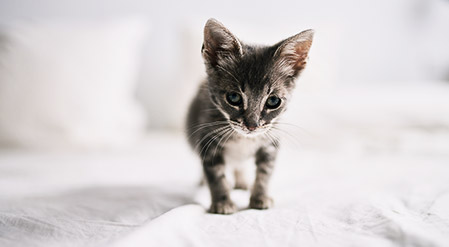
Once weaned, puppies and kittens need to eat three times daily until they are approximately 5-7 weeks old. Puppies and kittens should start with wet food and then progress to dry food only from 7 weeks of age.
At around 5-6 months of age, puppies and kittens should only be fed twice a day. By 12 months of age, reduce the number of meals to one a day.
LIFE-STAGE: ADULTS
Most adult cats and dogs only need one meal per day. However, some medium to large dog breeds, such as working dogs, need to be fed twice daily to accommodate their active lifestyle, and they have the amount of food provided at each meal adjusted to keep them at an appropriate weight.
LIFE-STAGE: SENIORS

Different breeds have different risks for certain conditions or diseases as the animal gets older. For example, certain breeds of dog appear to be predisposed to obesity. The daily energy requirement (DER) may vary considerably between breeds in the senior stage of life, making it even more important to consider the specific needs of the individual animal when designing feeding plans.
The three most important changes required for a senior’s diet are as follows.
- Reduce the amount of fat in the diet to prevent obesity because the animal’s activity tends to reduce with age.
- Increase the fibre content to assist with gut mobility.
- Reduce the amount of phosphorus to maintain and protect kidney health.
LIFE-STAGE: PREGNANT AND NURSING
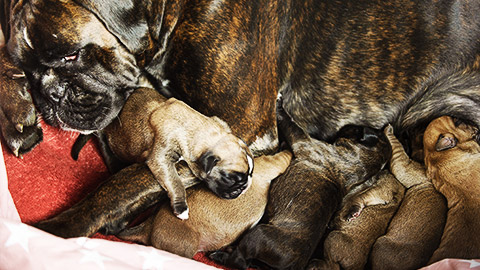
During pregnancy and lactation in cats and dogs, the mother (queen or bitch, respectively) has a much higher calorie and calcium need than usual. If she is not provided with the appropriate amount or type of food in this stage, she may not be able to produce enough high-quality milk for the babies.
It is recommended that pregnant and lactating cats and dogs are fed high-quality kitten or puppy food, respectively, because it contains the appropriate nutrient balance for this stage of life as well.
The role of supplements in a balanced diet
For most healthy animals, feeding should be one to three times daily depending on the age, breed, species and lifestyle. Providing them with high-quality commercial food will likely meet all their nutritional needs. High-quality foods will list the protein source as the first ingredient. They will also specify the source of the protein, such as salmon or chicken, rather than a more generic ‘fish’ or ‘poultry’.
Supplements are food products that can be given in addition to a normal diet. There are three roles of food supplements in an animal’s diet. To:
- add necessary nutrition that the animal may be missing or not gaining enough from their normal diet
- provide additional nutrition required by a medical condition
- make the food more appetising.
Supplements are most commonly added to a diet if specific nutritional requirements are not met by the diet alone or if there is a nutritional problem that has been medically diagnosed. For example, adding glucosamine, green lip mussels, fish oil, or chondroitin are common food supplements for dogs with arthritis or joint disease.
If an animal in your care requires food supplements, it will be included in their feeding plan along with the amounts required, how often you need to provide them and how to present them to the animal.
Vitamins and minerals are common food supplements if they are not adequately provided in the main food for specific dietary requirements. However, too much of a vitamin or mineral can be very harmful. For example, excess vitamin C can cause diarrhoea in some animals and excess calcium can cause a range of health problems in dogs.
Supplements should be used in conjunction with Veterinary advice. It is very important that you can identify the correct food and food supplements and prepare them in line with feeding plans.
Activity
Let’s go over some of the key points about animal nutrition. Complete the activity.
Complete the following four (4) tasks. Click the arrows to navigate between the tasks.
For the next activity you can type your answer into the boxes provided. Check your spelling if you don’t get it correct the first time!
Food Safety
As with preparing food for people, several potential hazards are involved in preparing food for animals. These hazards can be grouped into the following two main areas:
- Storing foods
- Preparing foods.
Hazards in storing food appropriately
The main hazards related to storing food is food contamination and food poisoning. As an animal care worker, it is your responsibility to make sure the food you feed to animals is fresh and hasn’t spoiled. Stale food may be unpleasant to eat and food that has gone off may cause animals to become sick. So, it is important to consider the following three aspects of storing food correctly:
- Store food in the right conditions
- Store food in appropriate containers
- Use or dispose of food as indicated by the use by and best before dates.
STORING FOOD IN APPROPRIATE CONDITIONS AND CONTAINERS
Open bags, packets and cans of food should be sealed with an airtight lid or placed in an airtight container. Airtight containers prevent food from becoming contaminated by bacteria, fungi and other pathogens that can cause food poisoning.
Wet and cut fresh foods should be stored in a refrigerator or freezer. The low temperature inside a refrigerator or freezer significantly slows down the growth of any bacteria that may be present in the food and further reduces the risk of food poisoning.
USE BY AND BEST BEFORE DATES
By law, in New Zealand, all food with a shelf life of less than two years, including packaged pet food, must be labelled with either a best before or a use by date.
The best before date indicates when the quality of the food may start to decrease, for example, go stale. It is still safe for animals to eat the food after this date, but it may not be as appealing as if it was before the best before date.
The use by date indicates when the manufacturers can no longer guarantee that the food has not spoiled or become contaminated. Animals that eat food after the use by date are at risk of food poisoning. You should throw away food once it reaches its use by date.
Hazards in preparing animal food
Common hazards to humans during the preparation of animal foods include:
- Manual handling of heavy, large or awkward containers of food as well as food preparation, storage and distribution equipment
- Sharps injuries (cuts and stabbing)
- Burns or scalding when preparing and handling hot foods
- Possibility of zoonotic infection.
Follow the work, health and safety (WHS) guidelines of your workplace to minimise these types of hazards. Report any concerns you have to your supervisor.
CROSS-CONTAMINATION OF FOOD
When dealing with food, you must work in a clean and hygienic environment as the risk of cross-contamination to animals and humans is extremely high.
Cross-contamination occurs when you transfer the bacteria from raw food (for example, chicken), unclean utensils, dirty hands and preparation surfaces (cutting boards and bench tops), onto foods that have been prepared and are ready to eat.
Contaminated food may cause the animal that eats it or the human that handles it, to become sick.
HYGIENIC FOOD PREPARATION AREA
Cross-contamination can be easily avoided by following some common procedures. Be sure to follow the procedures of your workplace for food preparation. The procedures are likely to include the following steps:
- Wash your hands thoroughly with soap before and after handling animal foods
- Wear gloves and other PPE, such as an apron
- Use separate utensils, cutting boards and other preparation equipment for each type of food you are preparing (for example, use a different knife and cutting board when cutting up fruit to when you cut up meat)
- Wipe down all surfaces before preparing food.
Reporting hazards
You need to verbally report any hazards or incidents you have encountered to your workplace supervisor. You should also fill out the appropriate WHS form and hand it to your WHS officer within a certain time frame.
Your supervisor should take appropriate measures to ensure that this hazard is dealt with and resolved efficiently and correctly.
Personal protective equipment for preparing food
Personal protective equipment (PPE) is one of the levels of the hierarchy of control in controlling the spread of infection. Using the PPE will help minimise the exposure of animal care staff to pathogens by decreasing the contamination of clothing and skin. It also reduces the risk of people transferring pathogens between staff and the animals.
Examples of some of the PPE equipment and clothing used in animal care facilities include:
- Aprons, scrub tops or overcoats - Their use means that street clothes cannot be contaminated.
- Gloves - Gloves, whether they are powdered or non-powdered, will reduce the risk of contamination.
- Masks and glasses - Masks and glasses protect your respiratory tract and your eyes.
When preparing food for animals, the key PPE are gloves and potentially an apron, scrub top or overcoat, depending on the type of food you are preparing. If you are working with food that may contain dust or mould and fungal spore, such as damp hay, you may also need to wear a mask and glasses.
Activity
The activity below reviews what we have just covered on food safety.
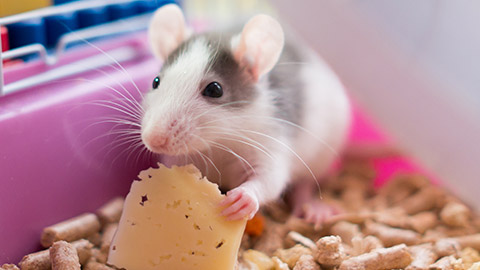
Suitable food and water containers
As part of preparing food for animals, you will need to select appropriate food and water containers for the animal. Where possible, choose:
- non-slip containers to reduce the chance of spills
- non-chewable containers to prevent:
- food and bacteria becoming trapped in the bite holes
- the animal from swallowing pieces of the container, resulting in potentially life-threatening internal blockages.
As the person preparing the food and water, you must first check all containers for any damage (cracks or holes) and contamination (not clean or dry) before food preparation. Correctly dispose of any damaged containers and locate suitable replacements.
Wash and dry contaminated containers before use or disposed of them, depending on the type of contamination. For example, a dirty bowl might be contaminated with old food and bacteria that could make the next animal sick. It is safe to wash and dry this bowl before reusing it. However, containers contaminated with potentially toxic chemicals need to be disposed of.
Food preparation techniques
Once you have ensured the food preparation area, utensils and other preparation equipment is clean and you are wearing the appropriate PPE, it is time to prepare the food for the animal.
Principles of food preparation
RAW MEAT AND POULTRY CAN CONTAIN HARMFUL BACTERIA, INCLUDING SALMONELLA, LISTERIA, CAMPYLOBACTER AND E. COLI THAT CAN CAUSE FOOD POISONING.NSW Government Food Authority n.d.
The principles of food preparation minimise the risk of cross-contamination and food poisoning. There are four principles of food preparation:
- Clean
- Separate
- Cook
- Chill
CLEAN
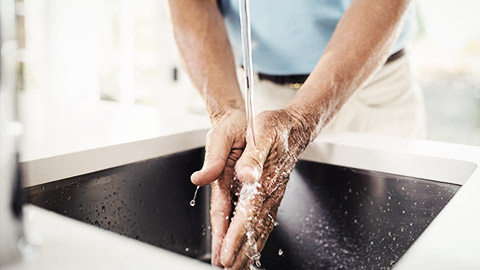
The first food preparation principle focuses on hygiene.
- Wash your hands well with soap before you start preparing food.
- If you are preparing multiple types of food, it is recommended that you wash your hands with soap frequently throughout the process.
- Wash your hands well with soap after you finish preparing food.
- After you finish, wash all utensils, cutting boards and surfaces with hot soapy water.
SEPARATE
The second principle focuses on preventing cross-contamination.
- Store the different food groups in separate places or in different containers. For example, raw meats should be stored in a different refrigerator to fresh fruits and vegetables, or at least in a different container if they are in the same refrigerator.
- When preparing different food groups, use different utensils and cutting boards.
COOK
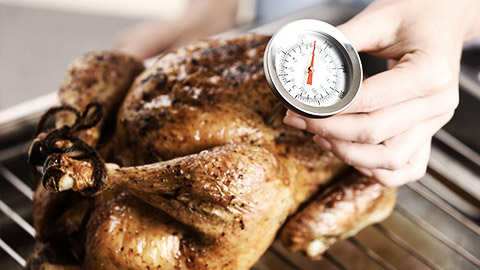
The third principle focuses on preventing food poisoning through heating. If you need to cook food before giving it to the animals, make sure to heat the food to the appropriate temperature. You may need to use a cooking thermometer to check.
The following table states the temperatures at which different types of meats should be cooked to destroy harmful microorganisms (NSW Government Food Authority n.d.).
| MEAT TYPES | SAFE TEMPERATURE |
|---|---|
| Fish | 63°C |
| Minced meat | 71°C |
Beef, veal, lamb, pork:
|
|
| Chicken and turkey | 74°C |
| Leftovers | 75°C |
CHILL
The final principle focuses on preventing food poisoning through chilling.
Store open wet food, raw meats and cut fruits and vegetables in the fridge or freezer at 4°C or below.
While most dry foods and uncut fruit and vegetables can be stored at 'room temperature', remember that the ambient temperature of a room will depend on the general climate of the area, and will change throughout the day and between seasons. If the temperature of the storage area is not consistent, air conditioning, temperature control or an alternative storage place may be required.
The following ranges are the generally accepted temperatures for the different storage locations:
- Freezer: -15°C or less
- Refrigerator: 2-8°C
- Cool: 8-15°C
- Room temperature: 15-25°C (ECA Foundation 2017).
Measuring the weight and volume of food
In most situations, it is likely that you will only need to measure out the amount of food to be provided to the animal, based on its feeding plan.
Case Study
Felix
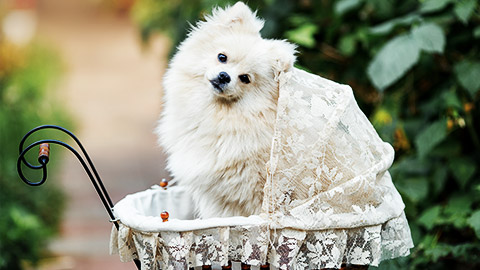
Felix is a 3-year-old Pomeranian who has just been dropped off at the SPCA boarding facility where Emily works. Her supervisor has asked her to weigh Felix and determine the appropriate amount of food he should be given each day. Felix is quite active and used to eating twice a day.
1. She weighs Felix and determines that he weighs 2.9 kg. 2. Based on his weight and life stage, he is to be fed Advance™ Adult Small Breed Turkey with Rice dry food for dogs. The following table shows the feeding guide for this type of food.
| INACTIVE DOG | ACTIVE DOG | |
| WEIGHT OF DOG | CUPS/DAY | CUPS/DAY |
| 2.5 kg | 1/2 | 1/2 |
| 5 kg | 2/3 | 3/4 |
| 7.5 kg | 1 | 1 1/4 |
| 10 kg | 1 | 1 1/3 |
| 12.5 kg | 1 1/2 | 1 2/3 |
| 15 kg | 1 2/3 | 1 3/4 |
| 1 cup (250 mL) = 115 grams | ||
Using the previous feeding guide, she identifies that she should feed Felix half a cup of dry food in total every day. This means Felix should receive 1/4 cup in the morning and 1/4 cup in the evening.
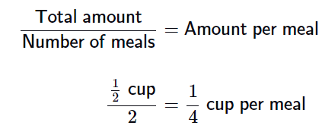
Most dry foods come with a measuring cup. However, the feeding guide typically indicates the volume and weight of a standard measure of the food as well. In the previous scenario, 1 cup of food is equal to 250 mL and 115 grams.
If the measuring cup is lost or damaged, you can measure each meal in grams, or kilograms as appropriate. For example, Felix requires 1/4 cup or 28.75 grams of dry food per meal.
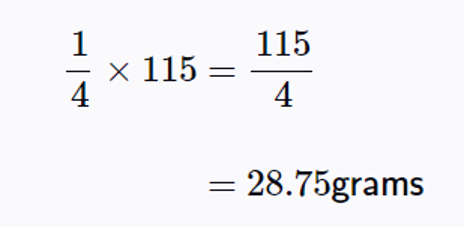
Activity
Time to review what we have just covered about nutrition and preparing food.
Complete the following five (5) tasks. Click the arrows to navigate between the tasks.
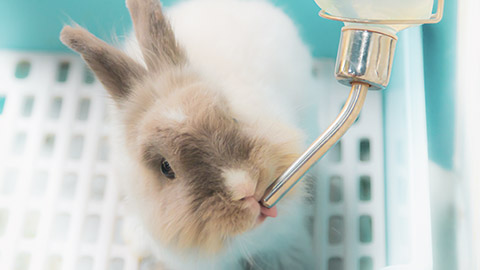
Upholding animal welfare principles when feeding
Before delivering the food and water to animals, let’s recap on the overarching eight principles of animal welfare which should guide you at all times in your actions towards an animal when feeding and caring for them.
Consider how the principles of animal welfare in the following table relate to delivering food safely and appropriately.
| PRINCIPLE | THE ANIMAL SHOULD HAVE ACCESS TO: | AS AN ANIMAL CARER, YOU SHOULD: |
|---|---|---|
| Animals should not suffer from prolonged hunger |
|
|
| Animals should not suffer from prolonged thirst |
|
|
| Animals should have a comfortable environment |
|
|
| Animals should have enough space to be able to move around freely |
|
|
| Animals should be free of physical injuries |
|
|
| Animals should be free of disease |
|
|
| Animals should not suffer pain, fear or stress |
|
|
| Animals should be able to express normal, non-harmful, social behaviours |
|
|
Keeping the principles in mind, when feeding an animal, you must consider how they might react and ensure the animals feel as little distress as possible during this process.
Case Study
Handling Watermelon the Guinea Pig
Let’s relate the animal welfare principles to how Emily would handle the guinea pig, Watermelon, should she need hand feeding. First, Emily should ask her supervisor to demonstrate appropriate handling techniques for guinea pigs or read about handling guinea pigs to ensure she doesn’t cause Watermelon any injury or stress. She will squeal in protest if Emily does or even bite if she is frightened or feels threatened.
Emily should approach her with two hands, using one to stop her from running forwards and the other backwards. As she picks her up, Emily should use one hand to support Watermelon’s tummy and the other to support her hindquarters, hugging her into Emily’s body or wrapping her in a cloth for security. Emily could then feed her knowing that she is safe, and Watermelon feels safe because she is being handled appropriately and respectfully.
The following video (1:25 min) demonstrates a safe way to pick up and support a guinea pig.
Before you handle any animal in your care, ensure you always seek training and knowledge on the unique characteristics of the particular animal and seek advice from your supervisor if in doubt.
Last checks before providing food and water
At this stage, you should be ready to feed and water the animals in your workplace according to their feeding plans. It is important to re-read the plan at this point to double-check that you:
- are feeding the correct animal the correct food
- identify potential hazards and behaviours of concern
- are wearing any PPE that you may need.
You must also read the workplace policies and procedures for monitoring animal feeding. The policies and procedures are in place to help you quickly identify health and behaviour problems or changes. Source this information in your animal care workplace, read it and implement it.
After carefully considering your feeding plan and workplace policies and procedures, you will now know if you need to put on PPE, how to approach the animal you are feeding safely, and what you need to observe, monitor, and record when feeding the animal or animals in your care.
How to deliver food in a manner that is safe and appropriate to the animal
Before commencing feeding any animal, it is essential to be aware of potential hazards that may exist or occur in food distribution. Consider the following hazards to animals and humans in food distribution.
Common hazards
- Animal movement and handling
- Excessive noise
- Organic and other dust
- Possibility of zoonotic infection
- Sharps injuries (cuts and stabbing)
- Temperature when handling foods and when serving foods to animals
- Amounts given (too little or too much)
- Slipping on water or food spills
- Medications (giving incorrect medication or not medicating animals when needed)
- Zoonotic diseases (not wearing the correct PPE when placing foods into cages)
- Manual handling
Hazardous animal behaviour during feeding
In the animal care industry, you need to understand animal temperaments and behaviours related to the associated hazards and risks to animals and staff during animal feeding.
It’s easy to evaluate animal behaviour by remembering three categories, as identified by the Madison Shelter Medicine Program:
- Interaction with people – how is the animal responding to you, and how has it responded to people previously?
- Acclimation – how is the animal responding to their new environment?
- Approachability – do you feel comfortable approaching this animal? Will you be safe? (University of Wisconsin Madison, 2015)
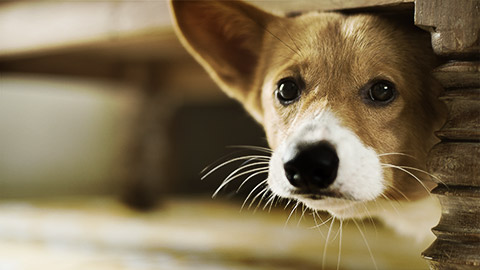
Cage cards, warning labels and animal histories will hold information about handling animals. Therefore, it is essential to read these to ensure you choose the best PPE and handling techniques for individual animals when feeding.
The following table summarises some common behaviours. Observe if your animal is displaying any of the following characteristics of animal behaviour and alter your approach to the task at hand accordingly.
| Behavioural indicators | |||
|---|---|---|---|
| INDICTORS OF CONFIDENCE AND WILLINGNESS TO BE APPROACHED | INDICATORS OF STRESS | SUBMISSIVE GESTURES | DEFENSIVE GESTURES |
|
|
|
|
You must understand the characteristics of the species and breeds you work with and know how to reduce the risks. For example, if you work with cats, make sure you have had training in and understand cat behaviour.
Indicators of Stress in Cats (pdf) ASPCApro-CommunalStressSigns.pdf from Daily Monitoring of Communal Cat Rooms is a good example of the type of detailed information you will need before approaching an animal.
Seek out the behavioural information relating to the animals in your care in your own workplace to keep yourself and the animal safe before, during and after feeding and watering. You should only work with species you are trained in and refer to any organisational policies and procedures pertaining to use of PPE and safe handling of animals.
Verbally report hazards or incidents you encounter to your workplace supervisor. If advised, use the appropriate work health and safety hazard, risk or incident form to fill in and hand to your WHS officer within the time frame as determined by your animal care workplace.
Your supervisor should take appropriate measures to ensure that this hazard or incident is dealt with and resolved efficiently and correctly.
Case Study
Bandit

Bandit is a 4 kg, 2-year-old domestic short-haired cat boarding at Wellington SPCA. It is his first time boarding and he is highly stressed, resulting in him lashing out, trying to escape, hiding and being very unpredictable in his behaviour.
Emily has provided his cat crate with the door off for him to hide in and Feliway spray is applied three times a day to his cage.
She notices that he has tipped over his water bowl. So she will need to supply him with more water. What would be the safest way to complete this task?
Activity
On a piece of paper, or on your device, write the steps that would take to approach Bandit and replace his water. When you are ready, check what you wrote against the list below. Click the + on the right-hand side to see the suggested approach.
- Assess his behaviour. However, given he is so unpredictable, he could trick you.
- Read his cage card and history to see if anyone has made notes on their successes in handling him. You could also ask other staff for updates.
- Once you are ready to approach Bandit’s enclosure, ensure all doors are closed to the cat ward if he manages to escape his enclosure. If he is in his cat crate, you could insert the door so that he is confined in his crate.
- Apply PPE such as cat gloves.
- Remove the empty bowl and replace it with a fresh one, so the door is open for less time.
- Remember to release him from his crate.
- Ensure you are moving calmly, quietly and with purpose at all times.
Select and correctly fit appropriate personal protective equipment
Once you have prepared the food, re-read the feeding plan and take note of your animal’s behaviour. Now it’s time to consider what personal protective equipment (PPE) you need to deliver the food, feed supplements and water safely.
PPE is one of the levels of the hierarchy of control in controlling the spread of infection. Using the PPE will help minimise exposure of the veterinary and animal care staff to pathogens by decreasing the contamination of clothing and skin. It is also a barrier between you and the animals’ natural weapons, such as talons, teeth, nails, hooves and beaks. Make sure all your PPE is correctly fitted before use. Otherwise, items like gloves or boots may produce further hazards by slipping off or tripping the wearer.
Common PPE in the animal care industry
Six common examples of PPE equipment and clothing used in veterinary or animal care practices to reduce the spread of infection include:
- Gowns (non-sterile)
- Lab (over)coats
- Scrub suits/tops/overalls
- Gloves
- Masks and glasses
- Footwear
GOWNS (NON-STERILE)
Non-sterile gowns will provide you more protection than a lab coat or a scrub top and are mostly used in association with gloves and masks when barrier nursing and handling animals that are suspected of having an infectious disease.
LAB (OVER)COATS
In veterinary and animal care practices, lab (over) coats should be worn when handling animals if there is no chance of splashing liquids.
SCRUB SUITS/TOPS/OVERALLS
Scrub suits, tops and overalls are more frequently used in veterinary clinics as protective wear. Their use means that everyday clothes cannot be contaminated. Overalls would commonly be used when dealing with large animals or in a kennel facility.
GLOVES
Gloves, whether they are powdered or non-powdered will reduce the risk of contamination. It is important that these are worn whenever there is a possibility of contact with any raw foods. Leather and other types of thick gloves are commonly used as a physical barrier. Ensure you select the right size for your hands, so they don’t slip off or constrain you while wearing them.
MASK AND GLASSES
Correctly fitting masks and glasses to protect your respiratory tract and eyes. Follow the instructions to ensure they are fitted correctly and protect you sufficiently.
FOOTWEAR
Many forget that correctly sized footwear plays an important role in daily PPE. The type of footwear to use depends on the animal and situation you are working in. For example, if you are dealing with large animals or working in a shelter you may wear boots, such as reinforced-toe boots or gumboots.
EXAMPLES OF PPE IN FEEDING ANIMALS
The following are a few examples of animals and the minimum PPE you should wear when feeding them:
- Rabbits – gloves
- Cats and dogs – gloves, long pants and boots or non-slip closed-in shoes and hearing protection in a kennel situation
When should PPE be used?
As useful as PPE is, it is one of the least effective control methods for protecting the user from risks. Therefore, PPE should only be used:
- as a last resort when the other control measures are not practical
- as an interim measure until a more effective way of controlling the risk can be used
- to supplement higher-level control measures.
Using protective equipment is vital, however, when working with animals who are known to be aggressive, especially if the animal requires restraint. Your workplace will have procedures related to the types of PPE you need to wear to stay safe at work and when to wear it. Always ensure you wear PPE correctly and ensure it is correctly fitted to provide the maximum level of safety for the task.
At a clinic or doggy day care wearing non-slip closed-in shoes would be sufficient. Footwear protects your feet if you stand on items and if an animal stands on your foot or you drop a sharp item.
Food and water vessels
Now it’s time to choose how you will present the food and water to the animal you are feeding. Your animal care workplace will already have dedicated feeding vessels. Which one you select will be dependent on the species, breed, age, medical needs and activity levels of the animal. You should be aware of the pros and cons of the selection.
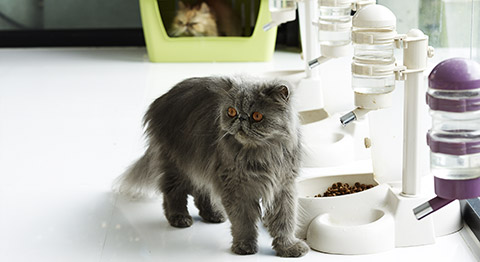
Considerations when selecting vessels
- Choose the material of the vessels carefully by understanding the characteristics of the species being fed. Stainless steel bowls are not only the most hygienic material as they are easily cleaned but also less likely to be damaged by animals chewing them. Ensure the vessel can’t be tipped or knocked over by the animal, in which case heavy ceramic bowls may be more suitable than stainless steel and plastic.
- Consider if the animal prefers a particular vessel.
- Consider the type of food being presented. For example, a liquid diet may require syringe delivery, whereas hay may need to be presented in a net.
- Specific medical needs of the animal will determine the type of vessel needed. For example, a raised bowl may be required for eating and swallowing conditions.
- Select an appropriately sized vessel for the animal.
- Food and water vessels are to be undamaged so as not to leak. Therefore, inspect them each day before use.
- Make sure food and water vessels are clean. Food vessels are to be dry before use when feeding an animal dry food.
- Consider how the vessel will be secured and where it will be placed. For example, will the vessel be hung on a cage or placed on the ground? Should it be placed in the shade?
- Carefully choose the location of water in relation to the food so it cannot be contaminated. For example, ensure food is not placed in a toileting area.
- Consider how many animals are being fed in one location.
- Water vessels are to be suitable for the animal and placed in such a way as to prevent leakage. For example, a guinea pig will need a drip water bottle and some cats prefer running water, such as a water fountain.
Case Study
Feeding vessels for Freya and Ravenna
Kai has posted another question to the ‘Disagreeable Bunnies’ social media group, this time on their rabbits’ water bowl.
| ShyK!w!Ka! | Hi again from New Zealand! My buns Freya and Ravenna currently have a large plastic water bowl that seems to annoy them. They drink from it, then they tip it upside down and throw it around their cage with their teeth. Is this normal bunny behaviour and what should I do about their water bowl? It’s kind of annoying having to clean up the split water twice a day. |
Activity
What would you recommend to Kai? Do some research on water for rabbits and make a suggestion to them. Post your response in the forum.
Reading
How to Choose the Best Dog Bowl
For more information about how to choose appropriate bowls for cats and dogs, review the article, 'How to Choose the Best Dog Bowl'
Expected Duration: 5 minutes
URL: https://www.purina.com/articles/dog/feeding/guides/how-to-choose-the-best-dog-
Post Read Task: Make notes for your own records if you need to.
Feeding methods
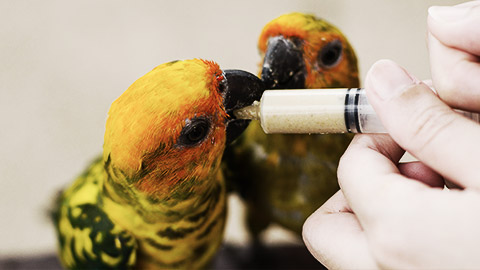
Always follow the feeding method outlined in the animal’s feeding plan. Feeding methods that are appropriate for the animal will depend on the animal's species, breed, age, and medical needs. Some common examples of feeding techniques for cats and dogs of various ages include:
- Hand feeding – to give food in fixed amounts and at a fixed time rather than allowing animal to self-feed. Often used when an animal is picky or has no appetite to encourage feeding, such as a syringe for kittens or rabbits.
- Adlib feeding, free feeding, free-access feeding, or grazing – where food is always available, and the animal can choose when to feed. Care should be taken that the animal is only allowed access to its daily energy requirements to avoid overfeeding.
- Bottle feeding – feeding from a bottle, commonly used in neonates such as when hand rearing kittens and puppies.
- Controlled feeding or scheduled feeding – animals are given food at an allocated time of day whether once, twice or more times in the day.
- Liquid diet – food is provided in a liquid form. This would be used when an animal is recovering from jaw or mouth surgery or after inappetence.
- Restricted diet or limited feeding – the animal is offered a certain amount of food as a single portion at a fixed time of the day.
Activity
Review your progress on feeding animals. Have a go at the following activity.
Complete the following two (2) tasks. Click the arrows to navigate between the tasks.
When giving food to your animal make sure that it is out of direct sunlight and away from contaminants such as dirt, soil and rubbish.
Position food and water vessels to avoid any spillage or contamination by urine or faeces. Ensure that vessels are always clean and free from contaminants. You will need to move them to a more appropriate area if they are not. Animals often overturn food and water bowls. Make sure the bowls are secured to stop this from happening.
Food and water are to be checked regularly to ensure they remain fresh and clean by replenishing when needed. During the summer months food and water is to be checked and changed more frequently. Food spoilage will be more rapid, and water will warm quickly. Ice blocks can be added to the water when experiencing high temperatures. Always ensure there is plenty of clean, fresh water available to avoid an animal getting dehydrated (except those undergoing treatments that require no water intake).
All uneaten food should be removed promptly to avoid any spoilage, attraction of vermin and food poisoning.
Once you have checked an animal’s food and water supply, you must record this on the animal’s record sheet including any replenishment.
Monitor feeding process to ensure animals are feeding effectively
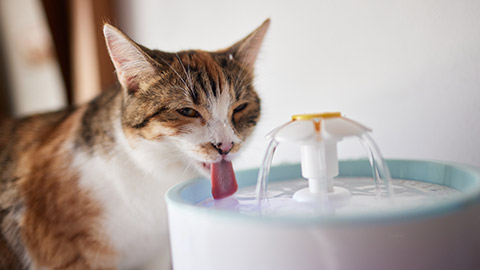
When food is placed into the animal’s cage, it will be recorded on the animal’s record monitoring chart with the date, time, type of food, amount given, and details. This will ensure that the animal is not over or underfed or watered. This food and water monitoring is performed manually by the person who fed the animal.
There are eight (8) common things that you may need to observe and record about how a particular animal eats and drinks:
- The time you provided food and water
- The type of food (and fluid, if not water) you provided
- The amount of food and water you provided
- The amount of provided food and water that was consumed by the animal
- Whether the animal has difficulty obtaining the food, chewing or swallowing food and/or water
- Any patterns in eating habits and behaviours
- Variations or abnormalities relating to individual eating and drinking patterns, such as vomiting
- Whether the animal has defecated or urinated (as an indication of the animal processes nutrients).
All animals should have their weight recorded upon arrival at a facility. Animals should then be weighed at the same time daily to ensure that the appropriate weight is maintained according to the animal’s problem (for example, losing weight in an obese animal, gaining weight in a puppy or kitten and maintaining weight in the healthy or sick animal). This will also determine how effective the food that they are given is.
Activity
What do you remember about monitoring feeding? Check below.
Observe variations in individual eating and drinking patterns and inform supervisor
It is not uncommon for animals staying within new environments to become fussy or refrain from eating and drinking. Learning tips and tricks to make food more appealing to animals is essential. Some animals will feel overwhelmed if offered too much food, so offering smaller meals more often can be a great way to tempt them to eat. Cats are crepuscular by nature, and it is not uncommon for stressed cats to only eat at night. 13 Tips for How to Get a Cat to Eat EVERY Time is a fantastic article on how to encourage cats to eat. The techniques discussed can be used for a variety of species.
Recording all information on the animal’s record sheet, especially any unusual behaviour or eating patterns, is essential. Make a general observation of sick animals, taking note of weight loss, diarrhoea and poor body condition. Observations may also reveal the animal has been vomiting, regurgitating, or has constipation. It is extremely important to verbally report any unusual behaviours to your supervisor as soon as you notice them prevent further decline. An animal may need to be referred to a veterinarian for further examination.
Eating and drinking abnormalities may include:
- Gorging (extreme overeating)
- increased water intake
- reluctance to eat
- reluctance to eat previously accepted foodstuffs.
Your observations may reveal that some animals prefer or need to have wet or can food over dry food. This needs to be noted down on the animal’s record chart, so the appropriate type of food is given.
Remember, also, that some animals are frightened and may only eat when it is quiet and no one is around (for example, overnight).
Recording this information should be done manually on the animal’s record sheet located in the animal’s folder on their cage. Any variations to the animal’s eating and drinking patterns, including abnormal behaviours or physical abnormalities should be recorded and immediately reported verbally to the supervisor and then, if applicable, to the animal’s veterinarian (Hollinger H., 2022).
Case Study
SCENARIO: OBSERVING WATERMELON’S FEEDING HABITS

One afternoon, Emily notices that Watermelon had not eaten any of her previous meal, there is evidence of diarrhoea in her cage, and she is not her usual active self.
Emily recorded this information on her cage card below and reported it to her supervisor.
| SPCA ANIMAL BOARDING | ||||||
|---|---|---|---|---|---|---|
| Animal name: Watermelon | Owner name: Truss Owner number: 0400 800 800 |
Species: Cavy (guinea pig) Breed: Satin Age: 1 year Colour: Golden |
Sex: Female Desexed: No Weight: 470g |
|||
| STAY | FEEDING | SERVICES | ||||
| Date in: 18/07/2022 Date out: 01/08/2022 |
Product: Fresh vegetables (named container in the fridge) Amount: 1/2 cup per meal Frequency/timing: Morning and evening |
Hydrobath - flea/tick: No Hydrobath - medicated: No Hand bath: No |
Clip (details): No Nail clip: Yes |
|||
| VACCINATIONS | PREVENTATIVE HEALTH | MEDICATION / SUPPLEMENTS | ||||
| Due date: n/a Type: |
Product: Due date: |
Product: Vitamin C powder Dose: 1/2 scoop daily Timing: Evening, on food |
||||
| Notes: | ||||||
| DATE | EAT | DRINK | URINE | FAECES | MEDICATION | NOTES: |
| 18/07/2022 am | ✔ all | ✔ | ✔ | ✔ | ||
| 18/07/2022 pm | ✔ half | ✔ | ✔ | ✔ | Vitamin C powder | |
| 19/07/2022 am | ✘ none | ✔ | ✔ | ✔ Runny | Lethargic | |
Activity
Check your learning on variations in feeding and drinking. Good luck!
